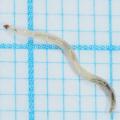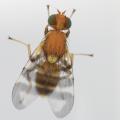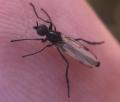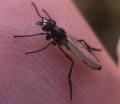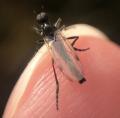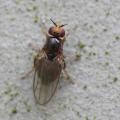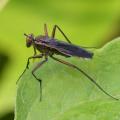Diptera.info :: Identification queries :: Diptera (adults)
Who is here? 1 guest(s)
Page 1 of 2: 12
|
|
Psychodidae
|
|
| markop |
Posted on 18-07-2007 23:17
|
|
Member Location: Crete, Greece Posts: 91 Joined: 13.10.06 |
I often find these tiny insects (~3mm) inside the house (in Crete, Greece) but this was the first time I decided to photograph one to see what it really looks like :-) When I saw the photo in the camera's LCD screen, I thought it was a moth, but later, when I saw it in full on the computer, I noticed that it didn't have scales on the wings, but hair... So my best guess is Trichoptera, although I haven't seen any quite like that... And why do I get the impression that there is only one pair of wings??? This insect sure is out of my league! EDIT: Changed the title, from "Tiny Trichoptera?" to "Psychodidae". markop attached the following image: 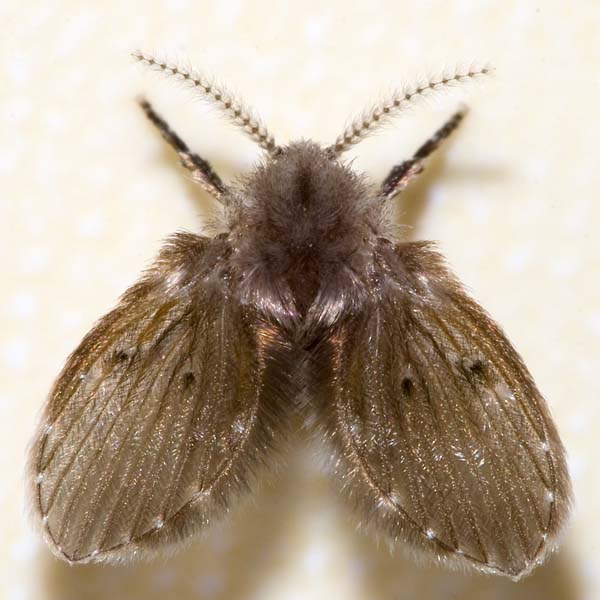 [71.07Kb] Edited by markop on 19-07-2007 10:11 |
| Nikita Vikhrev |
Posted on 18-07-2007 23:26
|
|
Member Location: Moscow, Russia Posts: 9225 Joined: 24.05.05 |
Diptera, Psychodidae
Nikita Vikhrev - Zool Museum of Moscow University |
|
|
|
| Juergen Peters |
Posted on 18-07-2007 23:26
|
|
Member Location: northwest Germany Posts: 13665 Joined: 11.09.04 |
Hello! And why do I get the impression that there is only one pair of wings??? Because it is in Diptera...  . It is Psychodidae, Pericoma sp. or near. . It is Psychodidae, Pericoma sp. or near.
Best regards, Jürgen -=-=-=-=-=-=-=-=-=-=-=-=-=-=-=-= Juergen Peters Borgholzhausen, Germany WWW: http://insektenfo... -=-=-=-=-=-=-=-=-=-=-=-=-=-=-=-= |
| Juergen Peters |
Posted on 18-07-2007 23:27
|
|
Member Location: northwest Germany Posts: 13665 Joined: 11.09.04 |
Nikita Vikhrev wrote: Diptera, Psychodidae Seconds earlier... 
Edited by Juergen Peters on 18-07-2007 23:28 Best regards, Jürgen -=-=-=-=-=-=-=-=-=-=-=-=-=-=-=-= Juergen Peters Borgholzhausen, Germany WWW: http://insektenfo... -=-=-=-=-=-=-=-=-=-=-=-=-=-=-=-= |
| Isidro |
Posted on 19-07-2007 00:23
|
|
Member Location: Zaragoza, Spain Posts: 2057 Joined: 26.04.07 |
Nikita, you have also telepathy with Juergen! You are a beast!!!!       |
|
|
|
| Xespok |
Posted on 19-07-2007 06:34
|
|
Member Location: Debrecen, Hungary Posts: 5550 Joined: 02.03.05 |
I think this is one of the common drain flies. It is a female of Clogmia albipunctata.
Gabor Keresztes Japan Wildlife Gallery Carpathian Basin Wildlife Gallery |
| jorgemotalmeida |
Posted on 19-07-2007 09:05
|
|
Member Location: Viseu - PORTUGAL Posts: 9296 Joined: 05.06.06 |
Juergen Peters wrote: Nikita Vikhrev wrote: Diptera, Psychodidae Seconds earlier...  What happens with Nikita? It seems to have strong telepathy!   Nikita, Juergen, and Stephane come to Portugal and obligate some flies to appear in front of us! It is a total coincidence that in the same day, Nikita has written at the same time... with Juergen and Stephane. Beware with Nikita! Nikita, Juergen, and Stephane come to Portugal and obligate some flies to appear in front of us! It is a total coincidence that in the same day, Nikita has written at the same time... with Juergen and Stephane. Beware with Nikita!  LOL LOL Yes, they are moth flies.  They can suck blood. They can suck blood.  Some are very annoying. Some are very annoying.  |
| Juergen Peters |
Posted on 19-07-2007 09:25
|
|
Member Location: northwest Germany Posts: 13665 Joined: 11.09.04 |
Hello, Jorge! jorgemotalmeida wrote: Yes, they are moth flies.  They can suck blood. They can suck blood.  Some are very annoying. Some are very annoying.  I'm lucky to live here high in the north  . All central european moth flies are perfectly harmless... . All central european moth flies are perfectly harmless...
Best regards, Jürgen -=-=-=-=-=-=-=-=-=-=-=-=-=-=-=-= Juergen Peters Borgholzhausen, Germany WWW: http://insektenfo... -=-=-=-=-=-=-=-=-=-=-=-=-=-=-=-= |
| markop |
Posted on 19-07-2007 09:55
|
|
Member Location: Crete, Greece Posts: 91 Joined: 13.10.06 |
LOL! Thank you all, my telepathic friends  You set me straight! Looks like I wasted a non-dipteran thread for a dipteran, after all  I looked it up some more and I found that they are sometimes called "bathroom flies", which is quite appropriate 99% of the time I find them in the bathroom  I don't know which Psychodidae species occur here in Crete... The photos of Clogmia albipunctata in Xespok's gallery match the appearance of my insect, but so do the Pericoma sp. (that Juergen mentioned) photos I found on the 'net... If anyone is sure about the genus (or species), then I could add it to the diptera gallery. Edited by markop on 19-07-2007 10:02 |
| Xespok |
Posted on 19-07-2007 11:47
|
|
Member Location: Debrecen, Hungary Posts: 5550 Joined: 02.03.05 |
I am pretty sure about this one. This is a cosmopolitan species, which I observed in Japan also. I got confirmation for this midge from both Japanese and European experts (Prof R. Wagner). Gabor Keresztes Japan Wildlife Gallery Carpathian Basin Wildlife Gallery |
| Nikita Vikhrev |
Posted on 19-07-2007 15:13
|
|
Member Location: Moscow, Russia Posts: 9225 Joined: 24.05.05 |
Markop: good photo for Gallery. Gabor: this Psychodidae from Thailand is also Clogmia albipunctata? Nikita Nikita Vikhrev attached the following image: 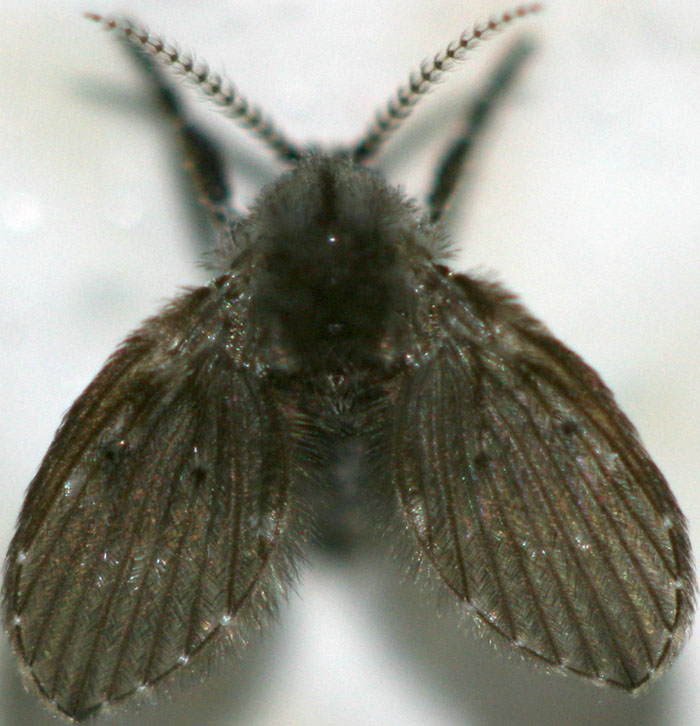 [120.15Kb] Nikita Vikhrev - Zool Museum of Moscow University |
|
|
|
| Juergen Peters |
Posted on 19-07-2007 20:15
|
|
Member Location: northwest Germany Posts: 13665 Joined: 11.09.04 |
Hello, all! Xespok wrote: I am pretty sure about this one. And if found in the bathroom, Pericoma or Ulomyia are not very likely. These bigger (4 mm) species mostly occur here in gardens and woods. I was mislead by the excellent quality of the picture  . I only manage to make such detailed photos from the mentioned bigger species. The very tiny ones I also find often in the house, but I mostly see them only as "flying spots"... . I only manage to make such detailed photos from the mentioned bigger species. The very tiny ones I also find often in the house, but I mostly see them only as "flying spots"... 
Best regards, Jürgen -=-=-=-=-=-=-=-=-=-=-=-=-=-=-=-= Juergen Peters Borgholzhausen, Germany WWW: http://insektenfo... -=-=-=-=-=-=-=-=-=-=-=-=-=-=-=-= |
| Xespok |
Posted on 19-07-2007 20:21
|
|
Member Location: Debrecen, Hungary Posts: 5550 Joined: 02.03.05 |
Yes Nikita, the same species. One can find these around most public toilets in Japan.
Gabor Keresztes Japan Wildlife Gallery Carpathian Basin Wildlife Gallery |
| Xespok |
Posted on 19-07-2007 20:29
|
|
Member Location: Debrecen, Hungary Posts: 5550 Joined: 02.03.05 |
Juergen Peters wrote: \Hello, all! Xespok wrote: I am pretty sure about this one. And if found in the bathroom, Pericoma or Ulomyia are not very likely. These bigger (4 mm) species mostly occur here in gardens and woods. I was mislead by the excellent quality of the picture  . I only manage to make such detailed photos from the mentioned bigger species. The very tiny ones I also find often in the house, but I mostly see them only as "flying spots"... . I only manage to make such detailed photos from the mentioned bigger species. The very tiny ones I also find often in the house, but I mostly see them only as "flying spots"...  OK let me clarify this issue. Drain fly is not a single species. It is any Psychodidae that thrives in the drainage of toilets, etc. There are several species, most are indistinct and are within Psychoda and Tinearia. These are greyish small midges, which hold their wings in a rooflike fashion. In addition Clogmia albopunctata also often occurs as a drain fly. This is a much larger species, among the largest Psychodids. (Sometimes placed within Telmatoscopus.) The males (seen rarely) and the females are somewhat different, and can be distinguished based on the photos. Interestingly Clogmia albopunctata is not on the Hungarian list, although this is a very abundant fly everywhere I go here. This indicates that this midge has spread in recent decades, when the Hungarian Psychodidae expert was not active any more. Gabor Keresztes Japan Wildlife Gallery Carpathian Basin Wildlife Gallery |
| markop |
Posted on 19-07-2007 21:56
|
|
Member Location: Crete, Greece Posts: 91 Joined: 13.10.06 |
Nikita Vikhrev wrote: Markop: good photo for Gallery. OK. I submitted a bigger version of this photo (1000x1000) to the gallery. |
| Juergen Peters |
Posted on 20-07-2007 00:10
|
|
Member Location: northwest Germany Posts: 13665 Joined: 11.09.04 |
Hello! Just for comparison: I went to the nightly garden and took a photo of the Pericoma/Ulomyias (?, 3-4 mm) living there. They can be found nearly all the year. Juergen Peters attached the following image: 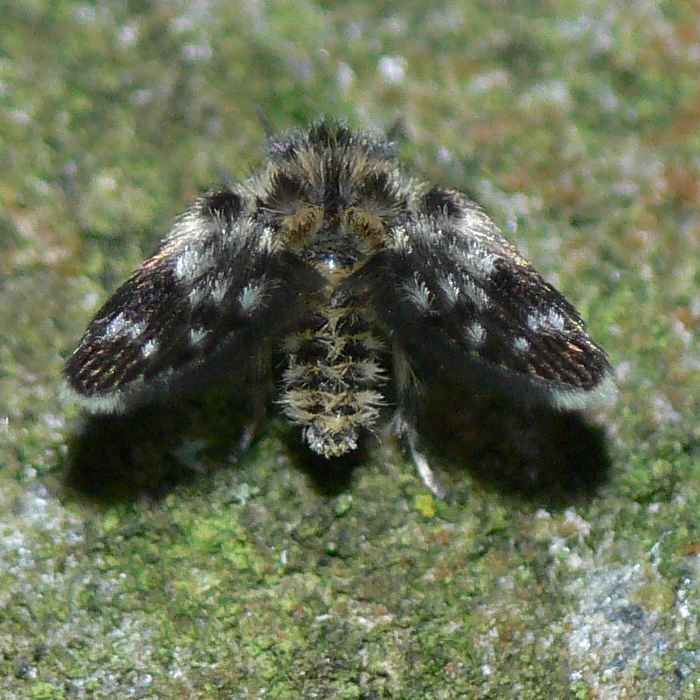 [46.39Kb] Edited by Juergen Peters on 20-07-2007 00:11 Best regards, Jürgen -=-=-=-=-=-=-=-=-=-=-=-=-=-=-=-= Juergen Peters Borgholzhausen, Germany WWW: http://insektenfo... -=-=-=-=-=-=-=-=-=-=-=-=-=-=-=-= |
| Louis Boumans |
Posted on 27-12-2008 01:01
|
|
Member Location: NO Oslo Posts: 262 Joined: 09.06.04 |
Xespok wrote: This is a much larger species, among the largest Psychodids. (Sometimes placed within Telmatoscopus.) The males (seen rarely) and the females are somewhat different, and can be distinguished based on the photos. Interestingly Clogmia albopunctata is not on the Hungarian list, although this is a very abundant fly everywhere I go here. This indicates that this midge has spread in recent decades, when the Hungarian Psychodidae expert was not active any more. Dear Gabor, Can you tell me a bit more about how to distinguish males and females of Clogmia albipunctata? I also have the impression that there are many more females than males. But so far I can only tell the difference when I remove the fur from the tip of their abdomen - I have no experience with Psychodidae! Also, do you happen to know who was the Hungarian Psychodidae expert, and when s/he became no longer active in this field? Thanks a lot in advance! Louis |
|
|
|
| phil withers |
Posted on 27-12-2008 13:50
|
|
Member Location: Lyon, France Posts: 521 Joined: 04.03.08 |
You tend to see more females in these situations because they are there for egg-laying; males are thus rarer, because most psychodids do not feed as adults and once mating has occurred the males do not last long. Females are distinguished (sometimes with difficulty) because of the presence of along ovipositor, whereas the males have a complicated apparatus, usually hidden in the scales. As to the Hungarian expert, I think Gabor is referring to Jeno Szabo, who died a long while ago. |
|
|
|
| Louis Boumans |
Posted on 28-12-2008 18:43
|
|
Member Location: NO Oslo Posts: 262 Joined: 09.06.04 |
Thank you Phil, I cannot see the male or female appendages on the pictures . Even when I have them at hand, it is difficult to see because the furry spines hide the details. I found some males but only after damaging the specimens. The easiest way for me - so far - is to put a bunch of dead specimens in warm 10% KOH for a couple of minutes, which also makes the scales detach. The males I found so far seem smaller than the females. I have another problem with the so-called ascoids, filamentous organs on each of the antennal segments. I cannot distinguish them from the numerous setae that form a whirl around each segment! Is there a method to make the ascoids visible? Thanks in advance, Louis |
|
|
|
| phil withers |
Posted on 28-12-2008 23:38
|
|
Member Location: Lyon, France Posts: 521 Joined: 04.03.08 |
Live psychodids put in alcohol usually shed their scales (this is how I collect them) and it is then much easier to tell the sexes apart. The scales are of no value in determining species. The ascoids are usually transparent, and probably shrink on dried specimens - these again are much easier to see on slide mounted material. |
|
|
|
Page 1 of 2: 12
| Jump to Forum: |



